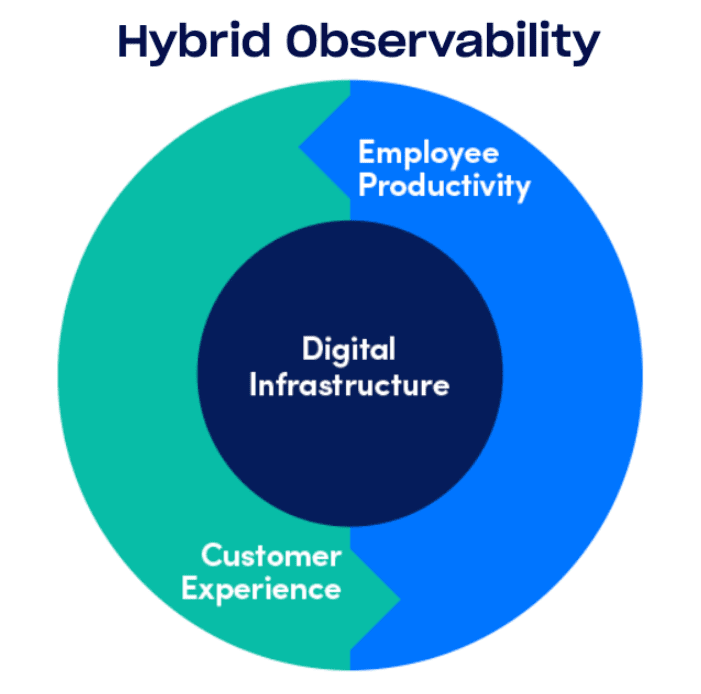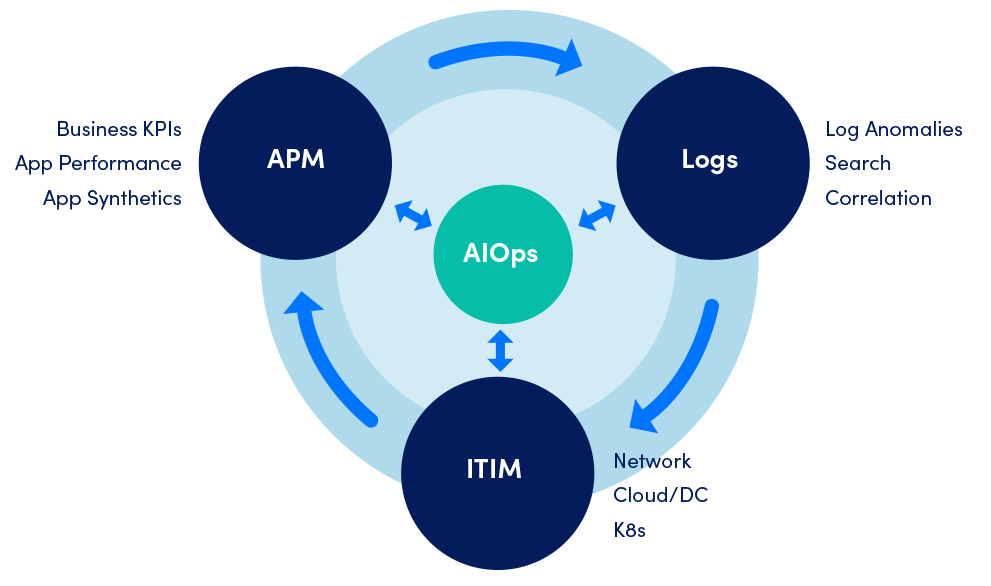Hybrid Observability Powered by AI: A Business-Centric View


Here at LogicMonitor, we’re on a mission to build the most comprehensive, extensible, and intelligent monitoring and observability platform in the world to help businesses run seamlessly. We’ve spent more than a decade building a best-in-class monitoring platform. Over the past two years, however, we have further evolved our platform to deliver invaluable end-to-end observability across applications, networks, and infrastructure for companies of all sizes and in a variety of industries. At LogicMonitor, we look at observability differently than other vendors. We view observability as a business imperative, rather than just metrics, logs, and traces coming together. Those are just the implementation details of achieving observability. The true value of observability can be realized only if you engineer observability to produce specific business outcomes.
Most businesses are already immersed in digital transformation initiatives. Teams and technologies are converging, and because of this, organizations are becoming more and more defined by software. A mere 10 years ago, an IT team’s primary job was to deploy and manage employee productivity tools such as email, CRM, business intelligence, etc. With digitization, that has all changed, because now the business itself runs on software. A company’s app is its business. Today, point solution monitoring tools or log management tools fail to provide the required observability context across your digital backbone. They don’t offer a unified view of near real-time performance across the entire enterprise.
Observability is about running your business efficiently by making every digital element of your business observable. For efficiency, you need every application, infrastructure, and business process to provide performance visibility in near real-time. And for that, you need to start with a rock-solid core of discovery and monitoring to then layer on the appropriate metrics that tie the business to the customer.
Until now, the industry has been talking about observability in a technical sense, but what does “observability” really mean to a digital business? If you take a cross-section of your enterprise, there are three pillars that matter: customer experience, employee productivity, and the digital infrastructure. To be a successful business today, you not only need complete visibility across these pillars but also need to be able to map the relationships between these pillars to achieve common outcomes and economies of scale. Let’s look at each pillar separately:

Today, much of a customer’s experience is conducted through mobile apps, websites, and social network interactions. Whether it’s a banking app, a taxi app, or a food-ordering app, the customer experience is conveyed through the app and a support response could be immediate via Twitter. Your app is your business; therefore if your app goes down, your business goes down. Customer experience is defined by how your users are perceiving your business through the lens of their individual app interactions. Therefore, having complete visibility into the performance of your applications that impact the business outcomes is paramount to the success of your business.
If your employees are not productive, then you will be unable to build the desired customer experience. Today, most of your employees rely upon SaaS services to perform their respective functions efficiently. Whether your organization uses Zoom, Salesforce.com, or Office 365, employee productivity depends upon the performance and availability of these SaaS products. Any disruption in these SaaS products will directly impact not only your employees’ productivity but also the customer experience. Therefore, your enterprise IT function needs to not only monitor the uptime but also the performance of your SaaS vendors as they may impact your employee productivity.
Digital infrastructures of today are dramatically different from what they were 10 years ago. Historically, infrastructures were centered around data centers, campus networks, email servers, ERP servers, etc. being maintained by an army of IT professionals. Today, they have evolved around clouds and containers. Both ITOps and Developers are now expected to operate at a lightning pace that helps businesses become more agile and release products faster. To achieve the required pace, the DevOps and ITOps functions need to be laser-focused on automation instead of manual workflows.
When these three pillars work in synergy, only then your business will be able to achieve hybrid observability that clearly depicts the performance and health of your digital business in near real-time. To achieve this competency, you need a platform approach to centrally bring the monitoring data of these three pillars together. Any observability platform is only as good as the business visibility it provides back to that business. For example, you can deploy a point-solution APM product that only provides you with trace performance. You can purchase a separate log management product that helps you with diagnostics and forensics. But, if you have to switch context across these tools throughout your day to solve problems, then you are losing troubleshooting efficiency across both the customer experience and employee productivity pillars of your business. You may also be introducing an observability blindspot into your organization due to contextual loss within the troubleshooting workflow. Ideally, you would take a business-centric view of hybrid observability that would allow you to get a pulse check on the following questions: Are our customers happy? Are our employees able to do their jobs well? Is our infrastructure bulletproof?
The technical definition of observability is a leading indicator of the business definition we have already discussed. Your business observability will only be as good as your technical observability. The KPIs you set for your technical observability must align with the final business KPIs. If they don’t, I’m sorry to say that your organization will end up with an “observability blindspot.” For example, if your application uses a SaaS payment web service that your current monitoring product cannot monitor effectively, then you already have an observability blindspot within your payment workflow.

In a technical sense, hybrid observability brings infrastructure monitoring (ITIM), logs, application performance monitoring (APM), and SaaS monitoring together into a single platform to provide organizations with complete visibility across their customer experience, employee productivity, and digital infrastructure pillars. It helps corporations build a world-class customer experience while boosting employee productivity. And it all starts with the different types of datasets that a hybrid observability platform can automatically collect and correlate: metrics, logs, traces, topology/relationships, and behaviors.
Why are each of these datasets so important?
Within a hybrid observability platform such as LogicMonitor, these datasets are then analyzed on a near real-time basis using operational analytics and AI/ML (AIOps) algorithms. These algorithms are continually monitored by LogicMonitor’s data science team for accuracy and are updated constantly to further improve performance. Customers of LogicMonitor do not have to worry about training any data models, and do not have to be experienced in data science to still glean the full benefits of the platform.
At LogicMonitor, we are obsessed with making our customers successful in their modernization and innovation initiatives. Whether you are digitally transforming your infrastructure or running business-critical applications in the cloud, our goal is to deliver a holistic platform that satisfies the needs of ITOps teams, developer teams, and MSPs today and tomorrow. The LogicMonitor team is continually shipping new products, and we are proud of the capabilities we have today that help thousands of customers run their businesses better with us:
Our engineers are working feverishly to bring LogicMonitor’s complete vision of hybrid observability to fruition. Our goal is to provide the world’s best companies with the world’s most comprehensive, extensible, and intelligent Hybrid Observability platform so that every function of your business runs seamlessly. Stay tuned for an exciting announcement later this month — and watch this space for more updates as we continue to deliver against our product promise.
© LogicMonitor 2025 | All rights reserved. | All trademarks, trade names, service marks, and logos referenced herein belong to their respective companies.
